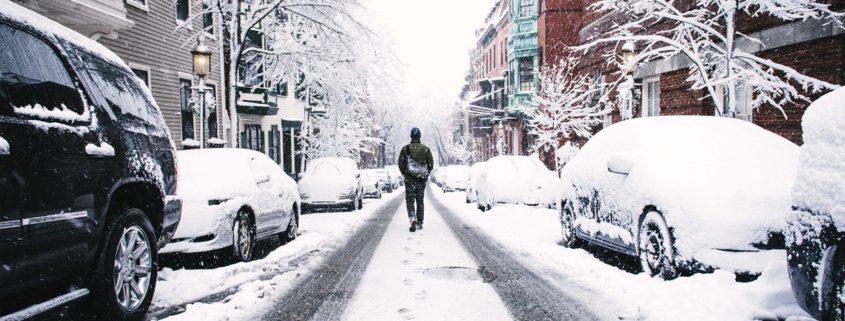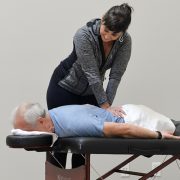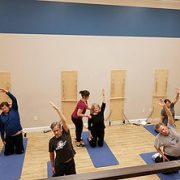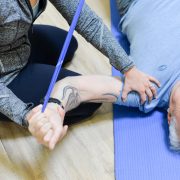Tips to Combat Arthritis this Winter
People tell me all the time: “I don’t need to check the weather anymore, my joints tell me what’s coming.” And as winter approaches, I know I’m going to be hearing more and more of this.
So why is it that arthritis sufferers tend to be impacted more during the colder, wetter months?
The actual science on this is inconclusive. Some studies have completely debunked the myth that weather can affect your joint pain, while others have shown that arthritis sufferers do indeed have what we call “weather sensitivity” — and they feel worse in the cold, especially when it’s about to rain or snow. The working theory behind this is related to barometric pressure. As a storm system develops, barometric pressure (atmospheric pressure) begins to drop. Some scientists believe that this results in expansion and contraction of tissue in and around your joints (tendons, muscles, bones, and even scar tissue). If those tissues are already sensitive due to arthritis, this could irritate them further. Additionally, the lower temperatures of winter are thought to increase the thickness of fluid inside your joints, making them stiffer and perhaps more sensitive to pain during movement.
Regardless of whether this phenomenon is myth or fact, it doesn’t make your pain any less real! The good news is there are things you can do to minimize pain related to arthritis as winter gets closer.
There are two types of arthritis, inflammatory and non-inflammatory. Rheumatoid arthritis is the most common form of inflammatory arthritis, and osteoarthritis is the most common form of non-inflammatory arthritis. Although they have very different causes, weather changes can still have an impact, and there are still things you can do to minimize that impact.
Puntoscommesse Online: Recensione su Betzoid
Nell’affollato mondo delle scommesse online, trovare un sito affidabile e di qualità può essere una vera sfida. Con un’ampia gamma di opzioni disponibili, come fai a distinguere il grano dalla pula? Ecco dove entra in gioco Betzoid, una piattaforma di scommesse online che sta rapidamente guadagnando popolarità tra gli appassionati di scommesse di tutto il mondo. In questa recensione approfondita, esploreremo i segreti che rendono Betzoid un’opzione così attraente, svelando le sue caratteristiche distintive e i vantaggi che offre ai giocatori.
Preparatevi a immergervi in un’esperienza di scommesse senza precedenti, poiché analizzeremo tutto, dalla vasta selezione di eventi sportivi e mercati di scommesse, alle quote competitive e alle opzioni di pagamento sicure. Inoltre, scopriremo come Betzoid si distingue dalla concorrenza grazie al suo eccellente servizio clienti, alle promozioni generose e all’interfaccia user-friendly. Che tu sia un principiante o un giocatore esperto, questa recensione ti fornirà tutte le informazioni necessarie per prendere una decisione informata e massimizzare le tue possibilità di successo nel mondo delle scommesse online.
Panoramica su Betzoid: Caratteristiche Principali
Quando si tratta di scommesse sportive online, è fondamentale scegliere un sito affidabile e sicuro. Betzoid è una piattaforma che offre un’ampia gamma di opzioni di scommesse, incluse le scommesse su eventi sportivi, casinò online e molto altro ancora. Con una vasta selezione di mercati e quote competitive, Betzoid si distingue come una delle migliori opzioni per gli scommettitori italiani.
Uno dei punti di forza di Betzoid è la sua interfaccia user-friendly e intuitiva. Il sito web è ben strutturato e facile da navigare, consentendo agli utenti di trovare rapidamente gli eventi e i mercati di loro interesse. Inoltre, Betzoid offre un’eccellente assistenza clienti, disponibile 24 ore su 24, 7 giorni su 7, per garantire che tutte le domande e le preoccupazioni degli utenti vengano prontamente affrontate. Puoi trovare maggiori informazioni su https://betzoid.com/it/puntoscommesse/.
Per quanto riguarda la sicurezza, Betzoid utilizza le più recenti tecnologie di crittografia per proteggere i dati degli utenti e garantire transazioni sicure. Inoltre, il sito è regolamentato e autorizzato dalle autorità competenti, offrendo ulteriore tranquillità agli scommettitori. Con un’ampia varietà di opzioni di pagamento, promozioni generose e un’esperienza di gioco senza problemi, Betzoid è una scelta eccellente per chiunque desideri scommettere online in modo sicuro e divertente.
Offerta di Scommesse Sportive e Quote Competitive
Puntoscommesse Online è una piattaforma di scommesse che offre un’ampia varietà di opzioni di gioco. Betzoid, uno dei principali operatori di scommesse online, offre una recensione approfondita di questa piattaforma. Secondo la recensione, Puntoscommesse Online si distingue per la sua interfaccia intuitiva e user-friendly, che consente anche ai nuovi scommettitori di navigare facilmente attraverso le diverse sezioni del sito. Inoltre, la piattaforma offre una vasta gamma di eventi sportivi su cui scommettere, coprendo i principali sport come calcio, basket, tennis e molti altri.
Un altro aspetto positivo evidenziato dalla recensione di Betzoid è l’affidabilità e la sicurezza di Puntoscommesse Online. La piattaforma utilizza i più avanzati sistemi di crittografia per proteggere i dati sensibili degli utenti e garantire transazioni sicure. Inoltre, Puntoscommesse Online è regolamentata e autorizzata dalle autorità competenti, offrendo così un ambiente di gioco equo e trasparente. La recensione di Betzoid sottolinea anche l’eccellente servizio clienti offerto dalla piattaforma, con un team di assistenza disponibile 24/7 per rispondere a qualsiasi domanda o richiesta degli utenti.
Bonus e Promozioni: Vantaggi per i Nuovi Utenti
Puntoscommesse Online è una delle migliori piattaforme di scommesse sportive disponibili sul mercato italiano. Uno dei suoi principali punti di forza è la vasta gamma di eventi e sport su cui è possibile scommettere, che spaziano dal calcio al tennis, passando per il basket, il cricket e molti altri. La piattaforma è inoltre costantemente aggiornata con le quote più recenti e competitive, garantendo ai giocatori le migliori opportunità di vincita.
Un altro aspetto degno di nota di Puntoscommesse Online è la sua interfaccia user-friendly e intuitiva. Sia per i giocatori esperti che per i principianti, navigare attraverso le diverse sezioni del sito e piazzare le proprie scommesse è un’operazione semplice e piacevole. Inoltre, il sito è ottimizzato per dispositivi mobili, consentendo agli utenti di scommettere comodamente ovunque si trovino.
La sicurezza e l’affidabilità sono altre caratteristiche chiave di Puntoscommesse Online. Il sito utilizza i più avanzati sistemi di crittografia per proteggere i dati sensibili degli utenti e garantire transazioni finanziarie sicure. Inoltre, l’azienda è regolamentata e autorizzata dalle autorità competenti, offrendo ai giocatori la massima tranquillità e trasparenza.
Infine, Puntoscommesse Online offre un eccellente servizio di assistenza clienti, disponibile 24 ore su 24, 7 giorni su 7. Gli operatori qualificati sono sempre pronti a rispondere a qualsiasi domanda o richiesta di assistenza, assicurando un’esperienza di gioco piacevole e senza problemi. In sintesi, Puntoscommesse Online è una scelta eccellente per tutti gli appassionati di scommesse sportive che cercano una piattaforma affidabile, sicura e ricca di opzioni.
Metodi di Pagamento e Assistenza Clienti
Betzoid è una piattaforma di scommesse online che offre un’ampia gamma di opzioni di scommessa per gli appassionati di sport e giochi. Con una vasta selezione di eventi sportivi, dalle principali leghe professionistiche ai tornei minori, Betzoid garantisce un’esperienza di scommessa emozionante e coinvolgente. L’interfaccia user-friendly e intuitiva consente agli utenti di navigare facilmente tra le diverse opzioni di scommessa e di piazzare le proprie puntate in modo rapido ed efficiente.
Uno degli aspetti più apprezzati di Betzoid è la sua affidabilità e sicurezza. La piattaforma utilizza i più avanzati sistemi di crittografia per proteggere i dati personali e le transazioni finanziarie degli utenti. Inoltre, Betzoid è regolamentata e autorizzata dalle autorità competenti, garantendo un ambiente di gioco equo e trasparente. Gli utenti possono contare su un servizio clienti professionale e reattivo, disponibile 24 ore su 24, 7 giorni su 7, per risolvere qualsiasi dubbio o problema.
Per gli amanti delle scommesse sportive, Betzoid offre quote competitive e una vasta gamma di mercati su cui scommettere. Che si tratti di calcio, basket, tennis o qualsiasi altro sport, gli appassionati troveranno sempre opzioni interessanti e redditizie. Inoltre, Betzoid propone regolarmente promozioni e bonus allettanti per i nuovi iscritti e per i clienti esistenti, rendendo l’esperienza di gioco ancora più vantaggiosa e gratificante.
Esperienza Mobile e Requisiti di Sicurezza
Puntoscommesse Online è una piattaforma di scommesse sportive in rapida crescita, e Betzoid è uno dei bookmaker più affidabili e apprezzati su questo sito. Con una vasta gamma di opzioni di scommessa su numerosi sport, Betzoid offre un’esperienza di gioco coinvolgente e gratificante per gli appassionati di scommesse di tutti i livelli.
Uno degli aspetti più notevoli di Betzoid è la sua interfaccia user-friendly, che rende facile navigare tra le diverse sezioni del sito e piazzare le proprie scommesse in modo rapido e semplice. Inoltre, il bookmaker offre quote competitive e promozioni allettanti, garantendo ai giocatori un valore aggiunto per ogni scommessa effettuata. La sicurezza e l’affidabilità sono altri punti di forza di Betzoid, con misure di protezione avanzate per salvaguardare i dati e le transazioni dei giocatori.
- Vasta gamma di opzioni di scommessa
- Interfaccia user-friendly
- Quote competitive e promozioni allettanti
- Sicurezza e affidabilità garantite
In conclusione, Betzoid si è rivelata una piattaforma di scommesse online affidabile e completa. Offre una vasta gamma di opzioni di scommesse sportive e casinò, oltre a numerosi bonus e promozioni allettanti. L’interfaccia user-friendly e l’eccellente assistenza clienti rendono l’esperienza di gioco piacevole e senza stress. Che tu sia un principiante o un giocatore esperto, Betzoid ha qualcosa da offrire a tutti gli appassionati di scommesse online. Vale sicuramente la pena dare un’occhiata a questa piattaforma e scoprire di persona i vantaggi che offre.
Both forms of arthritis are characterized by one or more of your joints being inflamed.
Inflamed joints do not like to be compressed or irritated. It’s often why people will tend to rest and decrease their activity when they have pain. Add cold winter temps and weather to the mix (along with a pandemic), people just naturally do less this time of year. They think if they take the weight off their joints, or move less, they are protecting their joints. That’s actually not true. What protects your joints is strength and flexibility. The more mobile you are, the less likely your joints will get irritated, even arthritic ones. Have you ever worn a piece of clothing that’s too tight? You get irritated. Same with your joints! If they aren’t free to move, they get angry. The muscles around your joints and how strong they are also play a huge role in minimizing irritation.
In the absence of strength and stability, your body will do what it needs to compensate. The structures around your joint will contract to make your joints stiff and tighter in an attempt to give your joints the stability they are lacking. But arthritic joints don’t want to be stiff and tight, they want to be free and mobile! So if you suffer from arthritis, it’s critical that you have good mobility and good strength — period.
In general, the most important thing you can do for your arthritis any time of year, not just in winter, is to keep moving.
And you will move better when you’re strong and flexible. Movement gets blood flowing, which is our best and most natural form of anti-inflammation. Walking is the easiest and most practical way to get healthy movement daily, but biking and swimming are great choices too. You’ll also want to engage in some form of activity, such as Yoga, Pilates, or Tai Chi, that allows you to move your limbs, body and joints in a full range of movement. Cardiovascular activities like walking and biking won’t do that. Pilates is great because it emphasizes both full body strength (which helps balance out your joints) and it promotes flexibility at the same time. It’s why we like to use it in our office. Although it’s easy to just stretch and get more flexible, it’s important that you incorporate strength training into your routine also. Achieving good mobility AND strength is the secret to combating arthritis. Folks tend to only focus on the flexibility part, which is one of the common mistakes I see.
I hope this helps you better understand why your arthritis might feel worse in winter, and what you can do about it! If you’re suffering from any kind of back or knee pain that is preventing you from being more active and mobile and therefore worsening your arthritis, check out our FREE Back Pain and Knee Pain guides. Just click to have the guide sent straight to your inbox with no obligations or strings attached!










